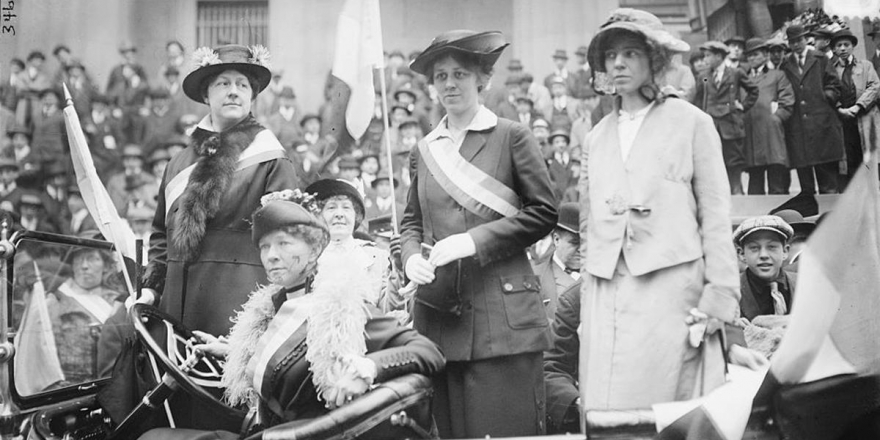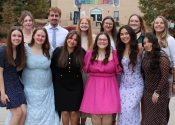
CSM professor talks Women’s Suffrage as 100 year anniversary approaches
- by Tammy Real-McKeighan, Fremont Tribune News Editor -
Sally Bisson-Best graduated from law school in 1981.
And she has women like Doris Stevens to thank for it.
Originally from Omaha, Stevens was part of the Women’s Suffrage Movement.
Stevens picketed the White House when Woodrow Wilson was president and she was thrown in jail. Stevens later wrote a book, telling how other incarcerated women were beaten and brutally force-fed.
History had all but forgotten Stevens who was part of a movement that spurred passage of the 19th Amendment to the Constitution in 1919.
That amendment gave women the right to vote.
Centuries later, Bisson-Best became a lawyer and associate professor, who was doing research when she learned about Stevens — and began sharing her story.
On March 5, Bisson-Best will talk about Stevens and the Women’s Suffrage Movement. The public is invited to the free event, which starts at 7 p.m. in the Mldland University dining hall, East Ninth and Pebble streets.
This year marks the 100th anniversary of the passage of the 19th amendment in June 1919. The amendment was ratified in August 1920.
To celebrate, the Lewis-Clark Chapter, Daughters of the American Revolution, together with the Dodge County Historical Society invited Bisson-Best to speak.
Bisson-Best is an associate professor and director of the American Bar Association-approved Legal Studies Program at the College of Saint Mary in Omaha.
At the college, Bisson-Best teaches a freshmen seminar class about women and their legal rights. She focuses on women’s suffrage and prepares her own materials for the course.
In her research, Bisson-Best found that Stevens was one of the most prominent leaders at the national level in getting women the right to vote.
She also learned that in the 1920s Stevens published a book called, “Jailed for Freedom.”
The book tells about women who picketed the White House to gain voting rights and were put in jail. In the back of the book, Stevens listed names and hometowns of all the women who were arrested.
That’s how Bisson-Best learned Stevens was from Omaha.
Stevens was born on Oct. 26, 1888 in Omaha, where she grew up and graduated from Central High School in the Class of 1905. She’d become involved in the suffrage fight while a student at Oberlin College in Ohio. She spent much of her life in New York, but returned frequently to Omaha to visit her family.
Bisson-Best would learn much about Stevens.
“She was very prominent,” Bisson-Best said. “She worked nationally and internationally for women’s rights. She was featured regularly in the Omaha World-Herald and the New York Times and very well known, but she really had kind of been forgotten in Omaha.”
That surprised Bisson-Best.
“If you’re from Nebraska, we tend to keep track of you and we’re proud of you and celebrate you,” she said.
To conduct her research, Bisson-Best was given a sabbatical from the college for a semester in 2014. She went to Washington, D.C. At home, she through newspaper archives.
The Nebraska State Historical Society gave her a grant. She used some of their materials and wrote an article for Nebraska History magazine set to come out in the fall of 2019.
Through her research, Bisson-Best learned that Stevens was in marches and traveled to various cities to campaign.
History would record that Stevens participated in the Silent Sentinels vigil at the White House under Woodrow Wilson’s administration. The women protesters gained that nickname because they stood silently with signs.
Stevens would be arrested and jailed between 1917 and 1918. Women who were jailed had been charged with obstructing traffic.
“And they weren’t obstructing anything so the charges were really rather flimsy, Bisson-Best said.
What’s more, they had a First Amendment right (freedom of speech and peaceable assembly) to be there.
While Stevens was jailed only shortly, other women were jailed for quite a while.
Some women were beaten and not allowed to see their attorneys.
“The essence of it was Woodrow Wilson was president and he did not want them picketing the White House, because he thought it made him look bad in the press. So he thought when he arrested the women, they would stop doing it — and they never did,” she said.
When the women were mistreated, they went on a hunger strike.
More than once, these women were force-fed raw eggs with tubes down their throats.
In her book, Stevens recorded this in a chapter called, “Night of Terror.”
“I thought I knew some history, but this was news to me,” Bisson-Best said. “Most people don’t learn this in their history courses, so this is a big piece of missing history as well.”
But Stevens provided details of what occurred.
“She really has the eye-witness account of the last year or so of the Women’s Suffrage Movement and when they were jailed, because that really was a turning point in getting Congress to pass the amendment — and to get Woodrow Wilson to stop opposing them,” Bisson-Best said.
Why would a president oppose the women?
That would take more research, but Bisson-Best takes into account this period of time.
“The country had gotten involved in World War I and I don’t know if his attention was turned more in that direction,” she said, adding, “It was very controversial for them to picket a war-time president, but they were willing to do it because they felt they’d lost ground during the Civil War trying to get women the right to vote on a national level.”
Stevens was not beaten nor in jail as long as some of the other women. She had an attorney friend, who became her first husband. He helped get some of the women released.
Bisson-Best said Stevens would work internationally in the United Kingdom and France for women’s equality.
After she retired from public life, Stevens wrote about her Nebraska childhood. She also wrote some songs about her childhood that were performed on the radio in New York.
Stevens’ first marriage wasn’t happy, but she was happily married to her second husband, Jonathon Mitchell from New York.
She died on March 22, 1963 in New York. She was 74 years old.
After she died, Mitchell made a $1 million gift to Princeton University and established one of the first endowed professorships in women’s studies.
It’s called the Doris Stevens Professorship.
Bisson-Best expresses admiration for Stevens.
“She was very ahead of her time,” Bisson-Best said. “She thought women should keep their maiden names. She always kept her maiden name when she married. She believed women should receive equal pay for equal work and she also thought women should be paid for doing housework.”
Those who attend Bisson-Best’s talk can learn more about Stevens.
“I hope they get to know a prominent Nebraskan native and my goal in researching her and speaking about her is — in a way — bringing her back to life so everyone in Nebraska gets to know this woman,” she said.
Bisson-Best also notes how Stevens’ work benefits women today.
“We all have benefited from the work of people like Doris Stevens, long before us,” she said. “I wouldn’t have gone to law school unless someone had fought for women’s equality, because they were routinely denied admission to law school. I graduated from law school in 1981 and I was only one of, I think, 30 women in a class of 140.
“I’m a direct beneficiary of the work of Doris Stevens.”
Photo: Doris Stevens, standing second from right, was an Omaha woman who had a key role in the Women’s Suffrage Movement, which urged passage of the 19th Amendment that gave women the right to vote.











